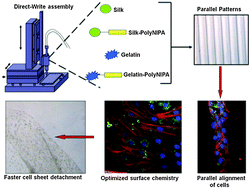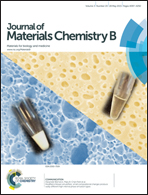Strategies for faster detachment of corneal cell sheet using micropatterned thermoresponsive matrices†
Abstract
The development of transplantable cell sheets of functional keratocytes embedded within an aligned collagen type I matrix is a viable approach for constructing a bioequivalent of corneal stroma. Thermoresponsive materials based on poly(N-isopropylacrylamide) (PolyNIPA) have been utilized to recover carrier-free corneal cell sheets by inducing temperature changes. In this study, we employed direct-write assembly (DWA) to develop microperiodic parallel patterns of silk–PolyNIPA and gelatin–PolyNIPA. Semi-interpenetrating networks of PolyNIPA hybrids (with silk/gelatin) exhibited temperature-responsive nature and thereby have potential use in cell sheet engineering. Silk–PolyNIPA and gelatin–PolyNIPA hybrids demonstrated a hydrophobic surface at 37 °C (i.e. above their lower critical solution temperature) with a contact angle of 59° ± 0.3° and 55° ± 3°, respectively, whereas the surface roughness of silk–PolyNIPA was double that of gelatin–PolyNIPA. The reduction of temperature to 20 °C resulted in a decrease in the value of surface roughness and water contact angle for both hybrids. All four parallel patterned substrates guided corneal cell alignment along the direction of the patterns. Collagen type-I and aggrecan gene expression was higher when the cells were grown over the gelatin–PolyNIPA matrix after 3 weeks of culture when compared to silk–PolyNIPA. In addition, a significantly higher metabolic activity as well as enhanced vinculin expression of keratocytes on the gelatin–PolyNIPA matrix indicated the improved cytocompability compared to the silk, gelatin and silk–PolyNIPA matrices. Interestingly, the detachment of keratocytes cell sheet was achieved from the silk–PolyNIPA and gelatin–PolyNIPA planar films only within 10 min and 30 min, respectively, but the patterns could not yield intact sheet recovery. Hence, we conclude that while gelatin–PolyNIPA hybrids with parallel patterns fabricated using DWA will benefit from the application of cellular alignment, some optimization in the pattern parameters may be required for rapid sheet recovery from such substrates. Understanding the keratocytes responses to such hybrid biomaterials suggests viable options to develop a corneal stromal bioequivalent.


 Please wait while we load your content...
Please wait while we load your content...